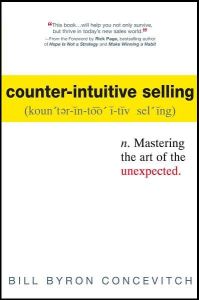
Counter-Intuitive Selling
Mastering the Art of the Unexpected
Recommendation
Bill Byron Concevitch believes that to make it as a salesperson, you must distinguish yourself from the pack. So, he suggests changing your behavior and doing something different simply because it’s different. He mixes tried-and-true sales advice, such as making sure you’re talking to the person who actually makes the purchasing decisions, with razzle-dazzle. His style is folksy and informal, almost associative, and he’s a great believer in mnemonics, acronyms and list making – each chapter ends with a list of “successful seven” action steps you can take to reinforce his suggestions. Some of his ideas may be more than “counterintuitive” – they’re probably counterproductive. (For example, that assistant who puts your call through because you convince him or her that the boss is expecting it will not make the mistake a second time.) But his book is a useful reminder to question your assumptions and to get out of your day-to-day rut. getAbstract recommends this book to both new and experienced salespeople, and their managers, who want to branch out and retrain themselves.
Summary
About the Author
Bill Byron Concevitch is an executive at a firm that develops software for call centers and specializes in training sales professionals.










Comment on this summary